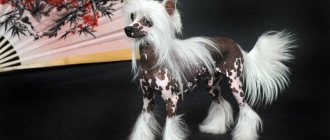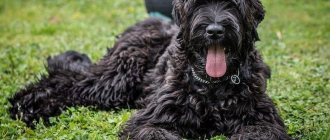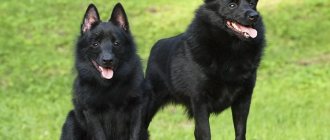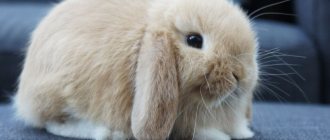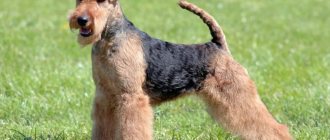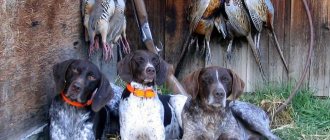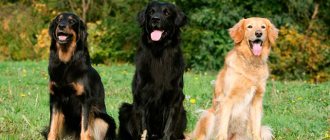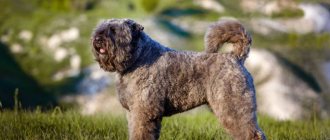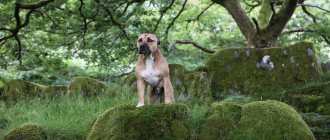History of the origin of the breed
The homeland of the miniature pinscher breed is Germany, where the first miniature smooth-haired pinschers or so-called miniature Dobermans appeared almost three centuries ago.
This is interesting! There are no reliable sources indicating the origin of the miniature pinscher, but the very first mentions of dogs similar in appearance to the miniature pinscher date back to the mid-fifteenth century.
According to some versions, the ancestors of the breed were Scandinavian dogs that lived on the Baltic shores and near Swiss lakes. Most likely, the black and tan English terrier was brought to Germany from Great Britain.
It was on the basis of this dog that it was possible to develop a smaller variety of the breed, rich in different colors, including brown, chocolate, light red, blue, as well as shiny black with very pronounced tan marks. Dogs with a very original deer color in Germany were called “Re-pinscher”.
Miniature Pinschers are an old breed, and some external resemblance to Doberman Pinschers was acquired post facto . Initially, pinschers were housed near stables, where small dogs were used not only as guards, but also for catching various rodents.
However, over time, this breed gained increased attention and gradually turned into a very popular house pet. Starting from the second half of the nineteenth century, German breeders began targeted breeding work with the aim of breed improvement of the miniature pinscher.
History of the breed
The history of the breed goes back 300 years. Germany is considered the birthplace of the miniature pinschers. There are no reliable sources when the first representatives of the breed appeared. It is known that similar dogs lived in Switzerland in the 15th century. According to another version, the ancestors of Pinschers came to Germany from England.
The similarity of the breed with Dobermans is no coincidence. Mr. Doberman set the goal of breeding large dogs, being delighted with miniature pinschers. Previously, representatives of the breed lived near the stables. They were excellent at catching rats and protecting the premises. Gradually they acquired the status of pets. Breeders became interested in the breed in the second half of the 19th century.
Initially, the pets were used as guard dogs. Only in the middle of the 15th century did they live in stables, catch mice and engage in intensive protection of domestic animals. At the beginning of the 20th century, small dogs began to be used exclusively as indoor decorative pets. Breeding and approval of breed standards began in Germany.
The Miniature Pinscher breed was first presented at an exhibition in England in 1954. Miniature representatives of the breed began to march through European countries, where they were recognized as an extremely popular breed.
Description of the Miniature Pinscher breed
The miniature pinscher is a harmoniously built animal; in its exterior it does not have the signs characteristic of dwarfism:
- There are very strict growth (at the withers 25-30 cm) of the animal. The weight of an adult dog is 4-6 kg.
- The body is compact, muscular, dry, with a deep square chest, somewhat sloping back and prominent withers.
- The front legs are of medium length, muscular, straight, set at a distance. The elbows are in the correct position, not turned out or tucked in. The structure of the paw is somewhat reminiscent of a cat's, with tightly closed, arched toes and medium-length black claws.
- The eyes are always dark in color, somewhat almond-shaped, without signs of bulging. They are located far apart on the muzzle, the eyelids close tightly and have dark pigmentation along the edges.
- The head is clearly defined, triangular in shape. Nose with a black mirror, straight back. The shape of the skull is oblong, smoothly turning into a gracefully curved neck. The forehead is smooth and has a not sharp, but pronounced transition to the base of the nose.
- The jaws close in a scissor bite, strong, with a full set of (42) teeth. Despite the fact that the chewing muscles are well developed, they do not violate the contours and do not protrude on the cheekbones. The lips are pigmented black, closed throughout.
- The ears are set high, erect or slightly drooping, triangular, giving the small dog a warlike appearance. Sometimes the ears are cropped, but this is not mandatory.
- The neck is quite long, has a smooth, noble bend without a pronounced transition to the withers. The skin fits tightly, there are no folds and dewlap or dewlap.
- The torso is strong, muscular, and compact due to the fact that the distance from the lower edge of the costal arch to the thigh is small. The lower abdomen forms a soft roundness that extends into the groin. The tail is docked in some countries, but most often it is natural.
Intrabreed types from different countries have some differences. American dogs have a compact, lean body with harmoniously defined muscles. They amaze with their grace and sophistication. Mini-pinschers from Israeli breeders are surprisingly similar in appearance to Doberman Pinschers and have a beautiful sweeping trot.
Powerful, muscular with a stocky torso, German mini-pinschers and calm Scandinavians, beautiful in their naturalness, also have their fans.
Description of the breed
These dogs are classified as domestic dogs. The height of this dog reaches 30 centimeters, and its weight is five kilograms.
They are almost square, since they have almost the same ratio of length and body height; from tail to withers they are as long as two heads.
These are smooth-haired dogs with a lively temperament and balanced character. Which allowed them to become the best among family dogs.
She has an oblong head, and the lobe is usually black, well-developed upper and lower jaws with a “scissor” bite. She has an elegant, thin, rather long neck. Thanks to its strong, straight limbs, the miniature pinscher moves smoothly and confidently, while its back remains straight.
Traditionally, their color is brown, but sand, black and tan, and even red are also found. They live 13-14 years.
Advantages and disadvantages
The Miniature Pinscher is a miniature but agile breed that is not suitable for couch potatoes or people in poor health. These dogs require active play and physical exercise, but they are unpretentious in food and living conditions, almost do not shed, and can be kept even in a small apartment. The main advantages and disadvantages of the breed are analyzed in detail in the table.
Table - Pros and cons of the miniature pinscher dog breed
| pros | Minuses |
| - Can be kept in a regular apartment; - endurance and good health; - developed protective instinct; - unproblematic wool; - rare shedding; - unpretentiousness in food; - learning ability | - They get cold in winter, they need clothes; - small for a watchman, but too active for decoration; - need regular physical activity; - require serious education; - may show willfulness or try to dominate the owner |
Care and education
Miniature Pinscher puppies, like adults, require careful care of their coat, teeth, and body as a whole.
In order for the dog to always be in shape, you need to take active walks every day, provide adequate nutrition (with all vitamins, macro-, microelements), train, and groom the dog.
Otherwise, if proper care is not provided, the dog may receive:
- obesity;
- formation of stones in the bladder;
- baldness;
- fragility of the musculoskeletal system, teeth.
Since childhood, the miniature pinscher adheres to the hierarchy in the “house”. If a dog from an early age is not accustomed to obeying its owners, then in the future it will be difficult to do so.
Cynologists of the Slavyanka kennel recommend starting the care and education of a puppy from the first day of arrival in a new home.
Under no circumstances should the puppy be allowed to play pranks or disturb the rules, otherwise the grown dog will constantly show disobedience.
Owners should know how to properly organize the care of a miniature pinscher and study its habits.
During training, according to the dog handlers of the Slavyanka kennel, you should not raise your voice, offend or beat the puppy. Otherwise, you can raise a frightened, angry, aggressive dog.
In order for the dog to obey and follow commands, owners must provide proper care:
- regular hygiene procedures;
- protective clothing (shoes), adequate nutrition;
- active walks.
As they say, miniature pinschers are easy to overfeed.
To avoid obesity, you need to organize regular physical activity.
Also, specialists from the Slavyanka kennel claim that if the pinscher does not have enough active walks, he may begin to spoil things in the house. Therefore, it is very important to organize your dog’s leisure time as actively as possible.
Character
The Miniature Pinscher is very cheerful and energetic, has high intelligence, attentiveness and passion. On the one hand, these dogs are affectionate and faithful, on the other – stubborn and wayward.
- Miniature Pinschers get along well with children and all family members.
- Despite their selfless love for their owner, these animals do not tolerate excessive displays of feelings and are not delighted with constant “tenderness” and stroking. Therefore, they can behave a little aggressively at such moments.
- Very distrustful of strangers.
- Miniature pinschers are friendly towards other pets, provided they have known them since childhood. If you are planning to have a new pet after the arrival of a miniature pinscher in the family, you should devote some time to adaptation and establishing contact between the animals.
- These dogs are very curious and enjoy getting to know everything new that surrounds them.
- During walks, it is better to keep your pet on a leash, because despite their miniature stature, miniature pinschers are very cocky towards other dogs, even if they are larger than them.
The peculiarity of the breed of these, at first glance, cute dogs is their very loud barking. They greet all the guests and animals who visit the master's house with it.
Care and maintenance of the Miniature Pinscher dog breed
It is not difficult to care for miniature pinschers and it does not take much time.
Walks. Miniature pinschers love to frolic in the fresh air, but they will not bother their owner. It is enough to walk with them in the morning and evening for 30 minutes.
Leash. It is recommended to choose a harness for your dog instead of a leash. After all, a curious fidget can jerk forward sharply and tear off the cervical vertebrae, and the harness wraps around the baby’s body and thereby protects from injury.
Wool. It is enough to comb the fur 2 times a week. In this case, it is better to choose a comb with natural bristles, so as not to injure the dog’s body.
General hygiene. There is no need to wash your pet frequently. Once a month or as needed is enough. You should choose a shampoo for short-haired dog breeds. Frequent bathing dries out the skin, causing itching and dandruff.
Eyes. Wash your dog’s eyes with a specialized lotion 1-2 times a week. You can use regular chamomile decoction for disinfection.
Ears. It is important to monitor the condition of your pet's ears. Once a week, as a preventive measure, clean the ears of wax with a cotton swab and wipe with ear lotions.
Teeth. It is recommended to brush your dog’s teeth (with a brush and toothpaste) 1-2 times a week so that they are always clean and caries and other dental diseases do not appear. Special treats are used to clean teeth.
Claws. You need to keep an eye on the claws. They need to be trimmed with a nail clipper. The claws should not be allowed to overgrow; this will create discomfort when moving.
Paws. After a walk, you need to check your paw pads. To make sure that your four-legged friend is not injured. In winter, treat paws against reagents with baby cream or Vaseline.
Timely vaccination, worming, treatment against blood-sucking insects and parasites are fundamental measures in the care of any dog.
Important: Miniature pinschers cannot tolerate low temperatures. Therefore, in cold weather it is necessary to wear overalls so that the dog does not catch a cold.
Training
Training a miniature pinscher is mainly aimed at controlling leadership aspirations. It is recommended to start training at 3-4 months, when the puppy’s nervous system has already formed and he is ready to understand the requirements and follow commands.
The training is based on the dogs' natural inclinations. Training should develop useful skills in the dog and minimize individual character flaws. The desire to assert leadership and aggressiveness with age can turn a dog into an evil creature that brings nothing but trouble.
Firmness in training is required, but the miniature pinscher should be treated with patience, introducing punishment only in extreme cases. The trainer must remember the proud, touchy nature of the dog. Rudeness and pity are equally unacceptable in raising a dog. He is very smart, and indulging his whims will quickly develop into manipulation.
But in general, the miniature pinscher responds well to training, and with the right approach, an active, playful puppy will grow into an intelligent, loyal, balanced companion.
Varieties
The Miniature Pinscher dog breed itself is not divided into varieties. In fact, she herself is a subspecies in the extensive pinscher family. The closest relatives of miniature pinschers are dogs of the following breeds.
- Doberman. The external double of miniature pinschers, only two to three times taller and much heavier. It is curious that the largest variety in the family was bred later than all others - towards the end of the 19th century. It can be assumed that the famous service qualities of Dobermans are the result of pinscher origin, and were inherited by these giants from their smaller brothers.
- German Pinscher. It became isolated as a breed at the end of the 18th century. A medium-sized type of pinscher that participated in the breed selection of other subtypes.
- Affenpinscher. Also a dwarf subspecies and the only long-haired representative of the family, although it was not bred for beauty, but as a pest fighter. Known since the beginning of the 17th century.
- Austrian Pinscher. A young subspecies, relative to the history of the breed, bred in Austria to protect farms from rodents. Has a long coat and medium size.
Requirements for maintenance and nutrition
These dogs can only be kept in an apartment or inside a private house, and only allowed outside for walks. The point is not only in the miniature size of an adult miniature pinscher, but also in the single-layer coat. They do not have insulation in the form of undercoat, so even in a temperate climate the dog is cold in the fall and winter and needs clothing.
Housing preparation
Compactness is an undoubted advantage of the miniature pinscher (miniature pinscher). These dogs can be kept even in the most modest apartment, but the smaller the living space, the more carefully you should approach its preparation for the new tenant. Even before purchasing a puppy, you should pay attention to several nuances.
- Create a relaxation area with a bed or blanket. A dog needs a place not only for sleeping, but also as a personal space where you can retire to relax or hide when you receive guests.
- Buy bowls for food and water. It makes sense to have a special set on the floor to make it easier to clean up after feeding your pet.
- Buy a tray and filler. If you plan to train your pet to the tray. Decide exactly where it will stand so that the dog gets used to one place once and for all.
- Secure the space. Remove wires, phone chargers, remote controls, etc. from the floor and other low surfaces that the puppy can chew. Get special toys that you can switch to when your animal wants to scratch its teeth.
- Buy a leash with a collar or harness. If you are planning to adopt an animal during the cold season, immediately get appropriate overalls for the puppy and, possibly, shoes.
Cupping
Traditionally, the ears and tail of pinschers, including dwarf ones, were cropped, which created a generally recognizable image of the breed. But today in Western cynological circles the general trend is the rejection of docking as such. In a number of countries, these operations are prohibited or limited; the modern breed standard does not require ear docking or tail docking. The decision is ultimately made by the owner, based on his own aesthetic preferences and career plans for the dog.
For those who decide to have docking done, they will need to have their pet's ears fitted after the stitches are removed. To do this, owners often create a simple frame structure from adhesive tape, cotton swabs or similar hygienic materials, which allows them to fix the dog’s ears in the desired position. The process takes up to two weeks. Once every three days, the structure is removed to allow the skin to rest a little, then a new one is assembled.
General recommendations for care and diet
Like other toy breeds, miniature pinschers are often litter trained to go to the toilet. To do this, in the first days, when the puppy is still not allowed to walk outside, you should closely monitor him and take him to the litter box at the first signs of anxiety. Some dog breeders believe that this skill is also useful for this breed in terms of preventing urolithiasis, since the dog does not have to endure it until you come home from work.
Please note that, while convenient, the tray does not replace walking. Physical activity is the key to the health of this breed. Otherwise, keeping a miniature pinscher does not require much time or effort. The main procedures and their frequency are described in the table.
Table - Caring for a miniature pinscher
| Procedure | Frequency | Comments |
| Grooming | — Once every 3 days; - daily during molting period | The coat is combed or wiped with a cloth to remove loose hairs. |
| Bathing | No more than once a quarter | Clothes will help prevent frequent soiling. |
| Inspection | — 1-2 times a week; — check for ticks after every walk in the warm season | - Clean the eyes and ears with a cotton pad; - redness or purulent discharge is a reason to contact a veterinarian |
| Nail trimming | 1 time every 2 weeks | Use a special nail clipper |
| Treatment for parasites | — Deworming — once every quarter or six months; - flea treatment - once a year | — Deworming must be carried out before vaccinations and mating: — the timing of re-treatment depends on the product used |
This breed is unpretentious in food, and it is up to the owner to decide what to feed the miniature pinscher - ready-made food or natural food. Dry food does not require cooking time, is stored longer and is more convenient to use. Natural food will allow you to control the quality of each product and diversify your menu. The main requirement for both nutrition schemes is high quality and balance.
Miniature pinschers are active and energetic, they need to fully replenish their energy supply, but at the same time they have an excellent appetite and, with the connivance of their owner, are prone to gaining excess weight. If you decide to feed dry food, it should not be cheaper than premium food. The quantity is determined according to the manufacturer's recommendation, taking into account the age of the dog.
The natural diet of an adult miniature pinscher must include:
- lean meat;
- boneless fish;
- dairy products;
- eggs;
- vegetables and fruits (green apples, carrots, beets).
The breed is not particularly prone to food allergies, but some of its representatives still suffer from this disorder.
If you notice itching or a rash on your dog's skin, change the food. New foods or products from new brands should be introduced into the diet gradually, monitoring the pet's reaction.
How to care for a pinscher
Many owners are deterred from purchasing a puppy by the need for daily care. But pinschers are not Yorkshire terriers or Maltese, where you can’t do without beauty treatments every day. Due to the fact that the animals are short-haired, there is no need to bathe and comb their hair weekly.
But despite the fact that the coat is short, a little care will still be required. Firstly, it is necessary to ensure that the animal does not become hypothermic. In cold and rainy seasons, it is best to put warm overalls on your dog, and, if necessary, shoes and even a hat. This is not a whim of dog breeders and a desire to dress up the animal in order to stand out from the crowd. This is an urgent need, since, despite moving and active walks, the body can become hypothermic, and this is already fraught with diseases and pathologies.
Grooming
Taking care of a dog's fur is easy and even enjoyable. It is enough just to go thoroughly over the entire body of the animal with a comb a couple of times a week to remove excess hair.
During seasonal shedding, you can either try to comb out dead hairs, or simply wipe the animal's body with a damp terry towel. Thanks to this procedure, without much difficulty and pain for the animal, you can get rid of the excess hair that will remain on the towel. The pinscher , like all dogs, sheds twice a year, in spring and autumn, so during this period it is important to help the animal get rid of dead excess hairs as quickly as possible.
There is no need to wash the animal weekly. In addition, systematic washing is harmful to health. The procedure removes the protective layer of oil from the coat, which can cause it to become brittle and deteriorate.
As for the paws, in dirty, rainy weather they must be washed. The reason for this is not only the cleanliness of the house, but also the hygienic aspect. Particles of dirt, microbes and bacteria can become fertile ground for inflammatory processes in the extremities.
Ear care
If you have a Pinscher, maintenance is minimal. But this does not mean that you should not monitor your dog at all. Particular attention should be paid to the animal's ears. Due to the fact that the pinscher's ears are erect and without hair, the “entrance” is open for insects and pathogenic bacteria. In addition, the dog is short and can pick up a tick on its way near short grass. Therefore, during warm periods, be sure to carefully inspect your ear, pinna, and area behind the ears every day, after each walk, for ticks. It is important to note that ticks, seemingly harmless bugs, can bring a lot of trouble to your pet. Inflammatory processes, infection with diseases and even death - all this is the work of just a small tick. Therefore, protect the animal and once again insure yourself. Buy a special flea and tick collar or systematically treat the animal with drops or sprays with this focus. You can buy them at any pet store.
In addition to daily examination, once a week it is necessary to clean your pet’s ears. This is easy enough to do. Take ear drops, cotton pads and swabs. Place a medicine in your ear that helps prevent earwax and neutralizes painful infections and bacteria. Lightly massage the outside of your ear and begin cleaning. First, use a cotton pad to wipe the inside of your ear to remove dust and dirt. Next up is the cotton swabs. Carefully and shallowly walk along the inside of the ear, not missing any bends. If necessary, replace the dirty cotton swab with a new one. Ear cleaning can be completed if the sticks and discs are completely clean after wiping.
Diseases and breed defects
The most common shortcomings and disqualifying defects of the miniature pinscher are:
- coarse or overly light build;
- short or high legs;
- heavy or rounded skull;
- folding on the forehead;
- short, pointed or narrow muzzle;
- direct bite;
- light, too small or too large eyes;
- low-set or very long ears;
- ears with different types of set;
- the presence of a dewlap;
- an excessively long, tight or soft back, as well as a hunchback;
- sloping croup;
- ambling or prancing step;
- rare wool.
A dog of this breed should not be cowardly, aggressive, angry or nervous, and should not have an underbite or underbite, or misalignment of the jaw. The most common hereditary and breed diseases of the miniature pinscher include:
- urolithiasis disease;
- tracheal collapse;
- diabetes;
- shoulder dislocation;
- Legg-Calvé-Perthes disease
- pannus;
- progressive degeneration of the retina;
- dystrophy of the ocular cornea;
- entropion of the eyelid;
- glaucoma and cataracts;
- epileptic seizures;
- congenital deafness.
Polytrauma, which develops when the pet falls from a great height, is quite common in miniature pinschers. Among other things, the miniature pinscher must be protected from cold and drafts, and to maintain health, it is necessary to provide the pet with systematic preventive veterinary examinations, timely vaccination, as well as long walks with outdoor games.
Pet's communication with the external environment
After the start of regular walks, the puppy’s socialization begins. To practice commands, it is better to choose deserted places where the dog will not be distracted by anything. But it is also necessary to walk with the puppy in crowded places, as well as places where other dogs are walked, so that he gets used to it and is not afraid of the noise of the streets and communication with his relatives.
Keep in mind that the social side of your pet’s life includes your company. The miniature pinscher, especially the small one, does not like loneliness, so gradually accustom him to being at home without his owners. Your first sudden exit from vacation to work may end in your apartment being destroyed by a bored dog.
Miniature pinschers can be trained from four months of age - this is a kind of adolescence, when the puppy develops character and the service qualities inherent in nature. The period is not easy, the dog gains self-confidence and may try to be cunning and manipulate its owner.
At four months of age, miniature pinschers grasp everything new almost on the fly. If you find the right motivation and organize activities in the form of active games, your pet will be more easily disciplined and will learn the necessary skills. It’s better to take a few lessons from a professional dog handler, who will tell you how to communicate more effectively with the animal.
Choosing a puppy
When choosing a puppy, you should first use a general rule: sit in front of the bitch's litter and call all the puppies at once. The most curious one will respond and run to you. Curiosity is a sign of a healthy animal. If there is no threat, then why run away? Puppies that do not show interest in a stranger are most likely weak and unhealthy. Sometimes there are scratches on the puppy's skin. You shouldn't focus on them. Young pinschers are so active in play that they often scratch each other. Then: See how all the miniature pinscher puppies behave. You need to pay attention to how they react to outside stimuli, how their mother plays with them. There should be activity and curiosity in everything. Be sure to pay attention to the bitch.
A well-fed and well-groomed mother will have the same puppies. If the animal is exhausted and sad, then the puppies will be in poor health and well-being. Check how the puppies eat. Healthy puppies eat the food offered at once. The nature of the miniature pinscher is such that if he is not sleeping, he is always busy with something. Therefore, you should be wary of puppies that are not active while awake. Check whether the puppy has the correct bite; Pay attention to dental health; The coat, eyes, mucous membranes of the mouth and nose must be clean; There should be no unpleasant odors coming from the ears and mouth; The coat should be smooth and shiny, without bald spots.
What age should you choose a dog?
It is preferable to purchase a dog when it is still a puppy.
The optimal age for a puppy is 2-3 months. During this period, miniature pinschers show curiosity and become independent. Their psyche is already established, so moving will no longer be too stressful for them. Adopting an adult dog is always worse than adopting a puppy. After all, she is already attached to her former owner, her character is already fully formed. For an adult Pinscher, moving will be very stressful. Before buying an adult dog, get to know it in advance, study its character and habits. It is very good if she is trained. Find out if the animal gets along with other pets, if you have any. How to prepare for the arrival of a puppy? Before you bring the puppy into the house, you need to: Set up a sleeping place for the dog; Determine the place where you will feed her; Learn more about how to care for your puppy; Decide on a veterinary clinic where you will go to get preventive vaccinations and periodically check your pet’s health. You need to decide on the toilet in advance. You can teach your four-legged friend to ask to go outside, but for such small breeds, a home toilet is quite acceptable, the location of which should be determined in advance.
NEAPOLITAN MASTIF: BREED STANDARD (APPEARANCE) AND GENERAL CHARACTERISTICS OF THE BREED
HUNGARIAN VIZSA: DISEASES AND CONTENT
Dachshund: HISTORY OF THE BREED, CHARACTER AND DISEASES OF THIS BREED OF DOG
COLLIE: HISTORY OF ORIGIN AND CHARACTER
Personality of the Miniature Pinscher
Dogs of this breed are very sociable, cunning, independent, but at the same time very attached to the owner, they love to play, they train well and adapt to living conditions, they are strong and resilient, but they need to be trained from puppyhood and a demanding and even harsh approach to education. Despite its small size, the miniature pinscher is quite courageous and inquisitive, it is perfect for people with an active lifestyle; you can play Frisbee or agility with it, or ride a bicycle through the forest.
This is an active, temperamental dog, which has a balanced character, is obedient, and is well trained. Loyal to his owner, fearless and vigilant, the miniature pinscher loves to bark. In relationships with relatives, he can act as a bully.
Miniature Pinschers are cute and gentle dogs. The main thing is not to spoil your miniature pinscher, otherwise he will turn into a dog that is not easy to live with. They can also be very stubborn, so early training is important for this breed.
Miniature Pinschers are full of energy and spirit. They get along well with children who understand that these dogs are not toys and need their own space, and are also very vulnerable due to their size.
Miniature Pinschers can be aggressive towards other dogs and only get along well with dogs they are familiar with from an early age. However, as a rule, miniature pinschers get along well with other animals in the house.
Naturally suspicious, Miniature Pinschers are prone to excessive barking. With proper training, miniature pinschers can safely receive guests, especially when they feel that their owner is not in danger.
These are loyal and cheerful dogs, but strong-willed and demanding. Luckily, Miniature Pinschers are quite intelligent and love to learn. Once these dogs recognize their owner, they will strive to please him and quickly learn to do what he wants them to do.
Due to their small size, miniature pinschers are excellent companion dogs, especially for lonely people. Miniature Pinschers puppies for life. They are playful, cheerful and curious. They can turn any thing in the house into a toy. Be careful, besides the fact that they can spoil something, it can also be dangerous for the dog’s health.
Today this breed is known all over the world and it is worth noting that it is very popular. The owners of representatives of this breed are world famous television stars. These dogs are unpretentious, they love when they are given attention, and always strive to be near their owners. They are very funny, especially when they feel that the owner is in a bad mood and try to cheer him up; it is simply impossible not to smile at such moments, because this little creature tries so hard to please its adored owner.
We advise you to read: Brussels Griffon Dog Breed
When getting a dog like a miniature pinscher, you must be prepared for the fact that a child will appear in your family. This is a very nimble and cheerful breed of dog, you need to constantly monitor them so that they don’t do something wrong somewhere. They are restless by nature, constantly on the move and demand the same from their owner. They are quite suitable for living in a city apartment, but they constantly ask to go for a walk; they don’t have enough room space, because the world is so big and they so want to see it.

